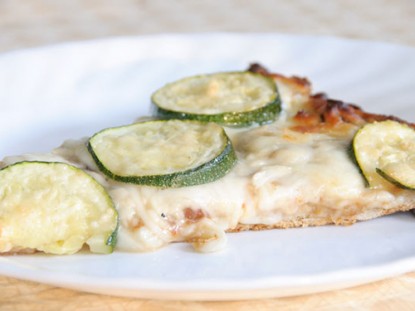
Pizza is a family tradition at our house. We’re particular about our toppings and crust, and harsh in our judgments about the not-quite-freshly-made pizzas sold at certain well-known chain restaurants. Even though none of us have so much as a drop of Italian blood in our veins, we’re all pretty sure we know the secret to making authentic Italian pizza the right way. Unfortunately, we each have a different opinion about which right way is more right.
My own love affair with pizza began decades ago when a swarthy Italian gentleman convinced the guy down the road to invest in his franchise. The guy down the road eventually hired my high school self to work in the kitchen. It was there that I learned to make real pizza the Angelo’s way. (I learned to make enormous pans of lasagna there as well and developed a taste for spumoni.)
My husband, on the other hand, grew up eating a very different style of pizza from the kitchen of a little Italian grocery in his hometown. Thus our twenty-eight-year marriage has been one of pizza compromise as we searched for the perfect restaurant pizza and struggled to make our own perfect pizza despite the limitations of our home kitchen. In time, each of our three children took after-school jobs in the kitchen of a pizza restaurant and learned the techniques for preparing yet another style of this family favorite. As adults, they’ve moved on to careers outside food service but pizza remains one of our bonding points whether we’re eating out or gathering in one of our kitchens to make it from scratch.
The pizza we make now steals bits and pieces from many styles and sources. We’ve no single recipe. Instead, we’ve a collection of combinations that work for us. The base recipe for the dough is simple: flour, water, yeast, salt, and oil. The flours vary, and sometimes the oils, but the proportions remain consistent. We’ve learned that a certain texture works best with our pizza paddle and pizza stone, that if the dough’s too wet it will stick to the paddle and create a terrible mess. We nearly always use the pizza stone because we like the results. The exception is our deep dish iron skillet pizza, which some of us love and some don’t.
The current seasonal favorite here at the farm is a whole wheat veggie pizza that showcases the last of this year’s zucchini crop. Preparation starts with the dough. These days I use a counter-top Hobart mixer with a dough hook, but this recipe’s easy enough to mix and knead by hand. I start the dough about an hour ahead of time on warm days, two hours ahead if the weather’s cooler. This allows plenty of time for the dough to rise and the yeast and gluten to develop properly.
The dough ingredients:
4 teaspoons instant yeast (2 packages)
2 cups tepid water
2 tablespoons raw sugar
1/4 tablespoons olive oil
1/2 cup vegetable oil
1 teaspoon salt
3 cups whole wheat flour
2 1/2 cups unbleached bread flour
Mixer instructions: Add all ingredients to the bowl and mix on low speed with dough hook until all ingredients are well-mixed. Let rest ten minutes, then knead with dough hook for 2-3 more minutes. Let rise until doubled. Punch down. Divide into two equal portions.
Hand mixing instructions: Whisk together the first five ingredients, making sure the sugar and yeast are dissolved. Stir the salt into the whole wheat flour, then add the dry mixture to the wet mixture. Stir with a wooden spoon until the mixture is smooth. Add the remaining flour in 1/2 cup increments, mixing well until the dough is too thick to stir. Turn onto a well-floured surface and knead in the remaining flour. When dough is smooth, cover and let rise until doubled. Punch down. Divide into two equal portions.
Finishing the dough: This dough works equally well for a pizza pan or cooking directly on a hot pizza stone. If using a pan, oil lightly and roll out the dough to fit. If using a pizza stone, be sure to preheat the oven to 450 degrees about 45 minutes before baking time so the stone has time to get hot enough.
I use a wooden pizza peel covered with a generous sprinkling of coarse cornmeal when I build a pizza.

First, the dough is rolled out into a round shape that’s no larger than the size of my pizza stone. Once it’s the right size, the dough is gently set in place over the cornmeal. The cornmeal keeps the dough from sticking to the wood, and it allows the pizza to slide more easily onto the stone. You have to work quickly from this point on, though, or the moisture from the dough will soften the cornmeal. Once that happens, the dough sticks to the board anyway.
The toppings for two 14-inch pizzas:
3-4 cups pizza sauce, purchased or homemade
2 lb. grated mozzarella cheese
2 lb. crimini mushrooms, sliced
2 lb. small zucchini, sliced
grated parmesan cheese
Spread the sauce evenly over the dough as thick or thin as you like. We like a generous amount of sauce and use quite a bit.
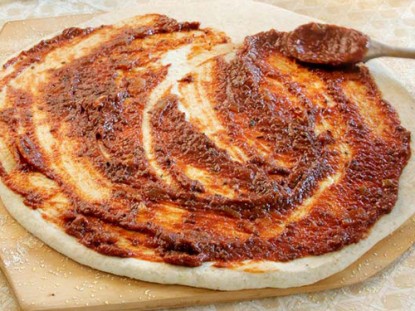
Add about a half pound of shredded mozzarella,

a layer of sliced mushrooms,
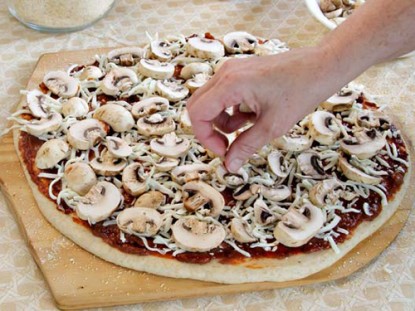
another layer of mozzarella,
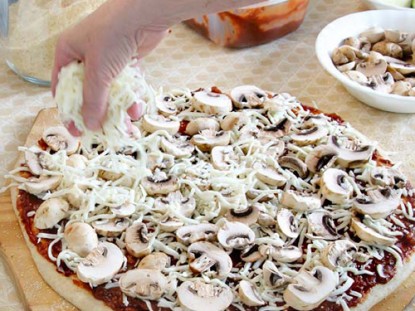
and finally, the sliced zucchini. (You don’t have to layer in this order. I do because I’ve found that the zucchini makes the pizza watery if it’s not on top where the extra moisture can evaporate from it. The same is true of the mushrooms if they’re under all the cheese. If they’re on top, they dry out more than I like.)
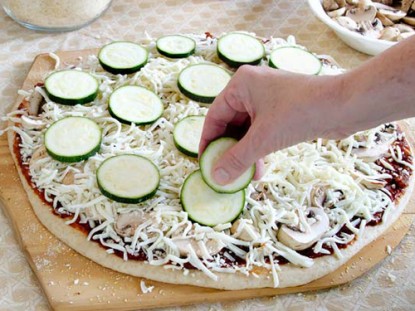
Finish by sprinkling the grated parmesan over the zucchini slices. You can sprinkle it on the slices only, or over the entire pizza — the choice is yours.
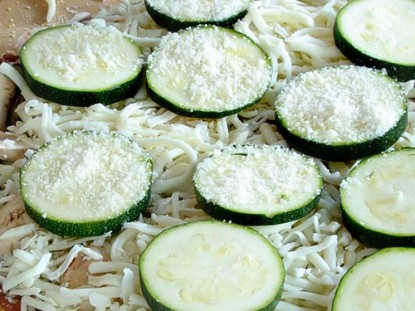
Bake 12-15 minutes at 450 degrees. Remove when the bottom has browned nicely and the cheese on top is bubbling and beginning to brown.
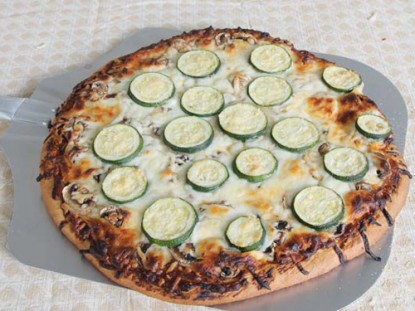
Let stand a minute or two to allow the cheese to set up a bit, then cut into slices. Otherwise it’ll stick to the cutting tool, string all over the place, and then the toppings slide here, there, and everywhere. Trust me, it just works better if you let your pizza breathe for a minute after it comes out of the oven.
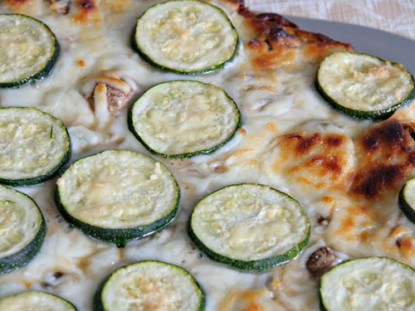
Recipe serves 16 nibblers or 4-8 normal pizza lovers.
Get the handy print page and save this to your recipe box here:
Whole Wheat Pizza Dough
Veggie Pizza
Laura blogs at The Land of Moo.Interested in contributing a guest post to the Farm Bell blog? Read information here for Farm Bell blog submissions.
Want to subscribe to the Farm Bell blog? Go here.



NorthCountryGirl says:
Laura, that looks good. Pizza is a big hit at our house too. I’ll have to give your recipe a try! Thanks!
On October 4, 2010 at 7:21 am
daiseymae says:
This looks so good. The most difficult part for me is sliding the pizza from the peel onto the stone. I’ve learned that they can’t be any bigger than 6″ in diameter or else they don’t slide and end up mucking up my oven real bad. Personal pizzas are all I can do, and it took me almost a year to learn that one very important lesson of pizza making!
On October 4, 2010 at 10:21 am
drucillajoy says:
we love pizza too, but using the stone is my biggest difficulty also…I’ve only used it a couple of times. It made a wonderfully baked pizza…crispy, crunchy & very pizza-parlour like, but it was such a mess to use..cornmeal everywhere & a pizza that only partly made it onto the stone. Of course I suppose it would help if I had the peel thing too(I used a cookie sheet), where, other than ebay, would one buy a peel? Thanks
On October 4, 2010 at 12:24 pm
LauraP says:
I think I got my peel from King Arthur Flour. I’ve seen them at a couple of restaurant supply stores lately, too.
A few tricks for working with a peel — lots of coarse grade cornmeal, a dough that’s not too wet, keep the peel close to horizontal as you jiggle the pizza off — too steep an angle, and it’s a guaranteed mess. Another trick I use when the dough sticks too much — such is when I thought I turned on the oven to heat the stone in time, but didn’t — slide the pizza onto parchment paper, which can still get messy but it’s not as much of a problem as messy on a hot stone. You can then cook the pizza on the parchment on top of the stone. You won’t get as good a crust, but it does work pretty well, and it’s certainly easier to slide the parchment around. Beyond that, it’s just a matter of practice.
On October 4, 2010 at 7:55 pm
Darlene in North GA says:
Anybody have a good recipe for pizza sauce. I have an ok spaghetti sauce, but I’d like a pizza sauce recipe. I know I can use the spaghetti sauce for the pizza, but I want a different taste and just can not for the life of me, get a good pizza sauce.
On October 6, 2010 at 10:07 am
Dede ~ wvhomecanner says:
Darlene, I had the same problem years back, then I discovered Mrs. Wages pizza sauce mix. It’s good. My (then younger) kids LOVED it. It’s the one thing I still make with a mix for canning. I just bought a package of Mrs. Wages a few weeks ago 🙂
Dede
On October 6, 2010 at 11:12 pm
Darlene in North GA says:
thanks Dede!
I don’t know that we have that brand here in north GA. I’ll have to look. I just get aggravated at myself for not being able to make a good pizza sauce. Normally, I AM a good cook, but not for pizza sauce.
On October 8, 2010 at 12:37 am
Dede ~ wvhomecanner says:
Darlene, you should be able to find it – here’s a link and there may be a store finder on their site:
http://store.mrswagesstore.com/mrswagpizsau.html
note that it IS high in sodium, but it’s difficult to avoid sodium when eating pizza 🙂
I can it in half pint (8 ounce) jars which is enough for two pizzas. Well, enough at my house anyway…..
Dede
On October 8, 2010 at 6:55 am